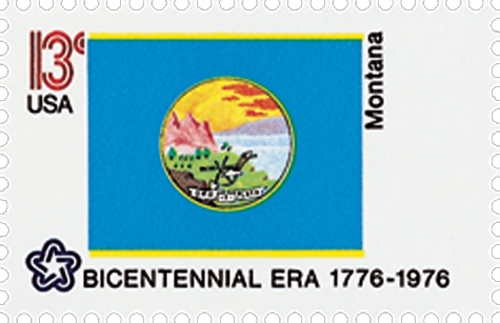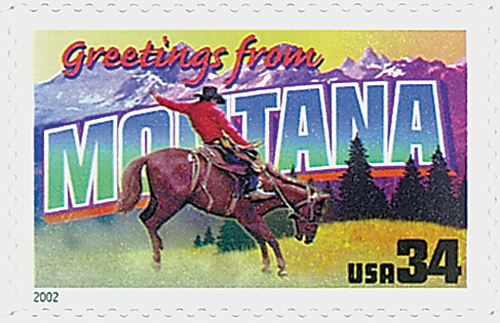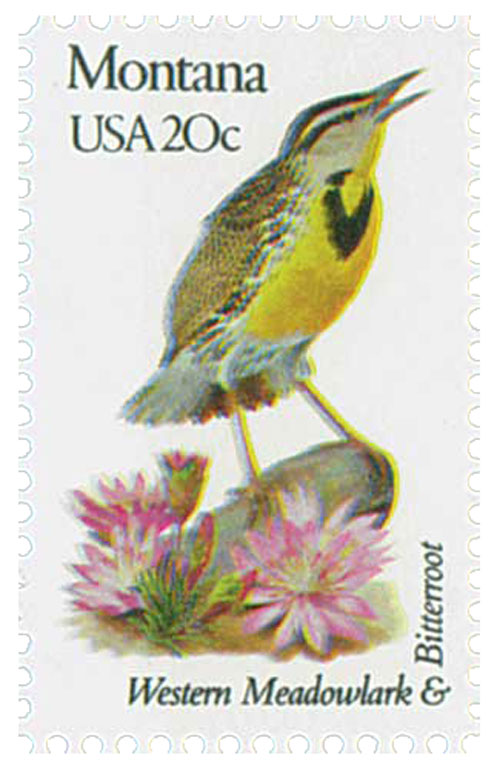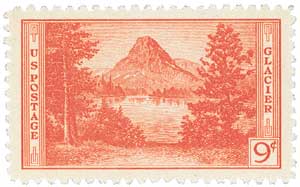
# 2401 FDC - 1989 25c Montana Statehood
25¢ Montana Statehood
City: Helena, MT
Quantity: 165,495,000
Printed By: Bureau of Engraving and Printing
Printing Method: Lithographed and engraved
Perforations: 11
Color: Multicolored
Montana Becomes 41st State
The many Indian tribes living in Montana before the arrival of Europeans could be separated into two groups, those who lived on the Plains and those who lived in the mountains. Plains Indian tribes included the Arapaho, Assiniboine, Atsina, Blackfeet, Cheyenne, and Crow. Mountain-dwelling tribes included the Bannock, Flathead, Kalispel, Kutenai, and Shoshone tribes. The Sioux, Mandan, and Nez Perce hunted in the Montana region, but usually lived elsewhere.
French trappers were probably the first whites to reach Montana, perhaps as early as the 1740s. The Lewis and Clark Expedition explored Montana on their way to the Pacific Coast in 1805 and when returning in 1806. By 1807, fur traders had come to the Montana area. Jesuit missionaries established St. Mary’s Mission in 1841. Located near today’s Stevensville, it was the first attempt to create a permanent settlement in the region. The American Fur Company built Fort Benton on the Missouri River in 1847. This is Montana’s oldest continuously populated town.

The U.S. acquired most of Montana with the Louisiana Purchase of 1803. A treaty gained the northwestern portion of the state with Great Britain in 1846. Montana was administered as part of the territories of Louisiana, Missouri, Nebraska, Dakota, Oregon, Washington, and Idaho.
Gold was discovered in Grasshopper Creek in southwestern Montana in 1862. Further discoveries led to a gold rush. Wild, often lawless, mining towns grew rapidly. To protect their towns, some citizens formed vigilante groups. These problems made people realize Montana needed its own effective government. On May 26, 1864, Montana became a territory.
Richard Grant brought the first cattle herd to Montana from Idaho in the mid-1850s. In 1866, Nelson Story drove a thousand longhorn cattle from Texas to Montana. With the arrival of the Northern Pacific Railroad in 1883, the eastern markets were opened to cattle ranchers. The industry grew quickly. Unfortunately, fierce weather destroyed thousands of Montana cattle during the winter of 1866 and ’67. Ranchers continued after this setback, but on a smaller scale.

Two of the most famous Indian battles in the west took place in Montana. Perhaps the most legendary was “Custer’s Last Stand.” On June 25, 1876, a combined force of Sioux and Cheyenne Indians killed many members of the 7th Cavalry Regiment under Lieutenant Colonel George A. Custer. This battle took place near the Little Big Horn River.
“Big Hole” was the last major Indian battle in Montana. This conflict started when U.S. troops attempted to force Nez Percé Indians onto a reservation in Oregon. The tribe’s leader, Chief Joseph, led his people on a daring escape toward Canada. After a series of minor battles, U.S. troops fought the Indians for two days at Big Hole in southwestern Montana. Chief Joseph managed to get his people to within 40 miles of the Canadian border before they were captured.
Montana was very attractive to settlers. Between 1880 and 1890, the population grew from about 39,000 to nearly 143,000. The territory’s citizenry asked for statehood in 1884. Five years later, on November 8, 1889, Montana achieved statehood.

The population explosion of the 1880s and ’90s was fueled by the discovery of Montana’s rich mineral resources. Gold, then silver, and copper attracted miners from other parts of the U.S. and Europe. Butte Hill was so laden with deposits of silver and copper that it became known as the Richest Hill on Earth.
As the state entered the 1900s, new efforts were made to harness its vast natural resources. Rivers were dammed, which provided irrigation for farm crops and hydroelectric power for industry. Railroads were expanded. Processing plants for sugar, flour, and meat were built. In 1910, Congress created Glacier National Park. This park soon began generating income for the state through tourism.
Montana elected the first woman to serve in the United States Congress. Jeannette Rankin was elected in 1916. Rankin later became famous as the only member of Congress to vote against entering World War II after the Japanese attack on Pearl Harbor.

Although the state’s economy suffered during the Great Depression, state and federal programs continued to improve its infrastructure. One of the major projects started at this time was the huge Fort Peck Dam. The dam was completed in 1940. Other projects included insect control, irrigation, rural electrification, and soil conservation.
During World War II, the demand for Montana’s metals and farm products created an economic boom. When the war ended, low farm prices created a migration to the cities as people searched for new work. In some cases, entire farm towns were abandoned.
During the 1950s, Montana’s oil industry expanded rapidly. Many productive wells were drilled in previously untapped areas. The Anaconda Aluminum Company built a $65 million plant in northwestern Montana in 1955. During the 1960s, this company spent another $50 million on improvements to its mining operations.
By the mid-1900s, tourism had become an important source of state income. Parks and historic sites were developed by the state. Private entrepreneurs created dude ranches, resorts, and skiing centers.

Many new irrigation and water projects were initiated in recent years. The Yellowtail Dam on the Bighorn River was completed in 1966. The Libby Dam hydroelectric project on Kootenai River began operating in 1975, and was completed in 1984. In 1972, the state’s voters approved a new constitution that went into effect in 1973. The energy shortages of the 1970s provided a boost to Montana’s gas, oil, and coal industries. In the 1980s, fuel prices fell, and production was reduced. Farm prices fell during the 1980s as well.
Today, Montana remains rich in natural resources. However, the state government has sought to broaden the base of its economy. Small businesses and electronics manufacturers have helped achieve this goal. In 1985, the state formed the Science and Technology Alliance to look for new ways to use its raw materials.
25¢ Montana Statehood
City: Helena, MT
Quantity: 165,495,000
Printed By: Bureau of Engraving and Printing
Printing Method: Lithographed and engraved
Perforations: 11
Color: Multicolored
Montana Becomes 41st State
The many Indian tribes living in Montana before the arrival of Europeans could be separated into two groups, those who lived on the Plains and those who lived in the mountains. Plains Indian tribes included the Arapaho, Assiniboine, Atsina, Blackfeet, Cheyenne, and Crow. Mountain-dwelling tribes included the Bannock, Flathead, Kalispel, Kutenai, and Shoshone tribes. The Sioux, Mandan, and Nez Perce hunted in the Montana region, but usually lived elsewhere.
French trappers were probably the first whites to reach Montana, perhaps as early as the 1740s. The Lewis and Clark Expedition explored Montana on their way to the Pacific Coast in 1805 and when returning in 1806. By 1807, fur traders had come to the Montana area. Jesuit missionaries established St. Mary’s Mission in 1841. Located near today’s Stevensville, it was the first attempt to create a permanent settlement in the region. The American Fur Company built Fort Benton on the Missouri River in 1847. This is Montana’s oldest continuously populated town.

The U.S. acquired most of Montana with the Louisiana Purchase of 1803. A treaty gained the northwestern portion of the state with Great Britain in 1846. Montana was administered as part of the territories of Louisiana, Missouri, Nebraska, Dakota, Oregon, Washington, and Idaho.
Gold was discovered in Grasshopper Creek in southwestern Montana in 1862. Further discoveries led to a gold rush. Wild, often lawless, mining towns grew rapidly. To protect their towns, some citizens formed vigilante groups. These problems made people realize Montana needed its own effective government. On May 26, 1864, Montana became a territory.
Richard Grant brought the first cattle herd to Montana from Idaho in the mid-1850s. In 1866, Nelson Story drove a thousand longhorn cattle from Texas to Montana. With the arrival of the Northern Pacific Railroad in 1883, the eastern markets were opened to cattle ranchers. The industry grew quickly. Unfortunately, fierce weather destroyed thousands of Montana cattle during the winter of 1866 and ’67. Ranchers continued after this setback, but on a smaller scale.

Two of the most famous Indian battles in the west took place in Montana. Perhaps the most legendary was “Custer’s Last Stand.” On June 25, 1876, a combined force of Sioux and Cheyenne Indians killed many members of the 7th Cavalry Regiment under Lieutenant Colonel George A. Custer. This battle took place near the Little Big Horn River.
“Big Hole” was the last major Indian battle in Montana. This conflict started when U.S. troops attempted to force Nez Percé Indians onto a reservation in Oregon. The tribe’s leader, Chief Joseph, led his people on a daring escape toward Canada. After a series of minor battles, U.S. troops fought the Indians for two days at Big Hole in southwestern Montana. Chief Joseph managed to get his people to within 40 miles of the Canadian border before they were captured.
Montana was very attractive to settlers. Between 1880 and 1890, the population grew from about 39,000 to nearly 143,000. The territory’s citizenry asked for statehood in 1884. Five years later, on November 8, 1889, Montana achieved statehood.

The population explosion of the 1880s and ’90s was fueled by the discovery of Montana’s rich mineral resources. Gold, then silver, and copper attracted miners from other parts of the U.S. and Europe. Butte Hill was so laden with deposits of silver and copper that it became known as the Richest Hill on Earth.
As the state entered the 1900s, new efforts were made to harness its vast natural resources. Rivers were dammed, which provided irrigation for farm crops and hydroelectric power for industry. Railroads were expanded. Processing plants for sugar, flour, and meat were built. In 1910, Congress created Glacier National Park. This park soon began generating income for the state through tourism.
Montana elected the first woman to serve in the United States Congress. Jeannette Rankin was elected in 1916. Rankin later became famous as the only member of Congress to vote against entering World War II after the Japanese attack on Pearl Harbor.

Although the state’s economy suffered during the Great Depression, state and federal programs continued to improve its infrastructure. One of the major projects started at this time was the huge Fort Peck Dam. The dam was completed in 1940. Other projects included insect control, irrigation, rural electrification, and soil conservation.
During World War II, the demand for Montana’s metals and farm products created an economic boom. When the war ended, low farm prices created a migration to the cities as people searched for new work. In some cases, entire farm towns were abandoned.
During the 1950s, Montana’s oil industry expanded rapidly. Many productive wells were drilled in previously untapped areas. The Anaconda Aluminum Company built a $65 million plant in northwestern Montana in 1955. During the 1960s, this company spent another $50 million on improvements to its mining operations.
By the mid-1900s, tourism had become an important source of state income. Parks and historic sites were developed by the state. Private entrepreneurs created dude ranches, resorts, and skiing centers.

Many new irrigation and water projects were initiated in recent years. The Yellowtail Dam on the Bighorn River was completed in 1966. The Libby Dam hydroelectric project on Kootenai River began operating in 1975, and was completed in 1984. In 1972, the state’s voters approved a new constitution that went into effect in 1973. The energy shortages of the 1970s provided a boost to Montana’s gas, oil, and coal industries. In the 1980s, fuel prices fell, and production was reduced. Farm prices fell during the 1980s as well.
Today, Montana remains rich in natural resources. However, the state government has sought to broaden the base of its economy. Small businesses and electronics manufacturers have helped achieve this goal. In 1985, the state formed the Science and Technology Alliance to look for new ways to use its raw materials.








